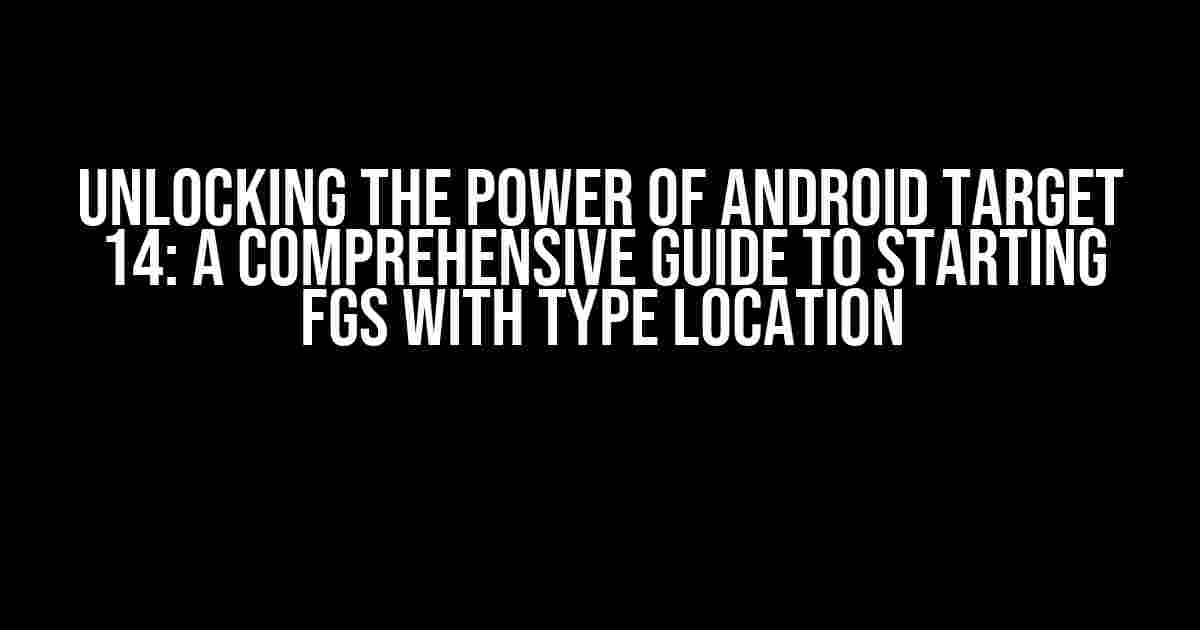Are you tired of struggling with GPS issues on your Android device? Do you want to unlock the full potential of your device’s location services? Look no further! In this article, we’ll delve into the world of Android Target 14, exploring how to start FGS (Fuse Geolocation Services) with type location. By the end of this tutorial, you’ll be equipped with the knowledge to optimize your device’s location capabilities and take your Android experience to the next level.
- What is Android Target 14?
- Why Start FGS with Type Location?
- Prerequisites
- Step 1: Enable Developer Options and USB Debugging
- Step 2: Install ADB and Fastboot
- Step 3: Enable FGS on Your Device
- Step 4: Configure FGS with Type Location
- Step 5: Verify FGS Status
- Troubleshooting Common Issues
- Conclusion
What is Android Target 14?
Android Target 14, also known as Android 14 (API level 29), is a significant upgrade to the Android operating system. Released in 2022, it brings a plethora of exciting features, including improved location services, enhanced security, and better performance. One of the key aspects of Android Target 14 is the introduction of FGS, which revolutionizes the way devices handle location data.
What is Fuse Geolocation Services (FGS)?
FGS is a cutting-edge technology that enables Android devices to provide more accurate and efficient location services. By fusing data from various sources, including GPS, Wi-Fi, and cellular networks, FGS provides a more comprehensive and reliable location experience. With FGS, your device can better determine its location, even in challenging environments.
Why Start FGS with Type Location?
Starting FGS with type location is essential for unlocking the full potential of Android Target 14’s location services. By configuring FGS to use type location, you can:
- Improve location accuracy and speed
- Enhance navigation and mapping experiences
- Optimize device performance and battery life
In this article, we’ll guide you through the step-by-step process of starting FGS with type location on your Android device.
Prerequisites
Before we dive into the tutorial, make sure you have:
- A device running Android Target 14 (API level 29) or later
- Root access to your device (optional but recommended)
- A basic understanding of Android development and command-line interfaces
Step 1: Enable Developer Options and USB Debugging
To start, enable Developer Options and USB Debugging on your device:
- Go to Settings > About phone > Build number
- Tap the Build number seven times to enable Developer Options
- Return to Settings > Developer options
- Scroll down and enable USB Debugging
Step 2: Install ADB and Fastboot
Next, install ADB (Android Debug Bridge) and Fastboot on your computer:
sudo apt-get install android-tools-adb android-tools-fastboot
(Note: The above command is for Linux-based systems. For Windows, download the Android SDK Platform Tools from the official Android website.)
Step 3: Enable FGS on Your Device
Using ADB, enable FGS on your device:
adb shell settings put global fg_enabled 1
Step 4: Configure FGS with Type Location
Now, configure FGS to use type location:
adb shell settings put global fg_type_location_enabled 1
Step 5: Verify FGS Status
Use the following command to verify that FGS is enabled and configured correctly:
adb shell dumpsys fg
(Note: The output should indicate that FGS is enabled and using type location.)
Troubleshooting Common Issues
If you encounter any issues during the process, refer to the following troubleshooting table:
| Issue | Solution |
|---|---|
| FGS not enabled | Check that you have enabled FGS in Step 3 |
| Type location not configured | Verify that you have configured FGS with type location in Step 4 |
| Device not rooted | Root your device and retry the process |
Conclusion
By following this comprehensive guide, you should now have successfully started FGS with type location on your Android device. With FGS enabled, you can enjoy improved location accuracy, faster navigation, and better overall device performance. Remember to stay up-to-date with the latest Android updates and continue to explore the exciting features of Android Target 14.
Happy coding, and don’t forget to share your experiences with us in the comments below!
Frequently Asked Questions
Get ready to dive into the world of Android target 14 – Starting FGS with type location!
What is Android target 14 – Starting FGS with type location?
Android target 14 – Starting FGS with type location is a feature that allows developers to start foreground services (FGS) with the `android.permission.ACCESS_FINE_LOCATION` permission, enabling more accurate location-based services and features in their apps.
Why do I need to start FGS with type location?
Starting FGS with type location provides more precise location data, which is essential for various use cases, such as navigation, tracking, and location-based gaming. It also allows developers to access more advanced location features, like GPS, Wi-Fi, and cellular data.
How do I start FGS with type location in my Android app?
To start FGS with type location, you need to declare the `android.permission.ACCESS_FINE_LOCATION` permission in your app’s manifest file and then use the `startForegroundService()` method with the `LOCATION` type. You can also use the `requestLocationUpdates()` method to receive location updates.
What are the benefits of starting FGS with type location?
The benefits of starting FGS with type location include improved location accuracy, increased app performance, and enhanced user experience. It also enables developers to create more sophisticated location-based features and services that require high-precision location data.
Are there any specific requirements or restrictions for starting FGS with type location?
Yes, starting FGS with type location requires a minimum Android API level of 14 (Android 4.0) and the `android.permission.ACCESS_FINE_LOCATION` permission. Developers must also ensure that their app complies with the Android privacy policies and guidelines for location-based services.
